Honey mesquite
Prosopis glandulosa var. glandulosa Torr. Fabaceae (Bean or Legume Family)
Mesquite is a small tree or shrub, usually armed with straight, very stout spines that produces edible fruits called legumes, beans, or pods. A signature plant of the South Texas Plains, mesquite, perhaps more than any other plant, is characteristic of the region (Johnston 1963). This plant was used in many different ways by native peoples. Its nutritious pods were highly valued as an important food resource rich in sugar and protein, its hard wood was used for making tools, musical instruments, and fuel, and the plant had medicinal and ritual uses as well.
The yellow-green mesquite leaves are compound, that is a single leaf is composed of several small leaflets. Honey mesquite is widely distributed across the southwest into Mexico. The cylindrical, cream colored flower spikes are actually composed of dozens of tiny flowers. The fruit is a bean or legume, slightly curved usually measuring 6-10 inches. The fruit or pod ripens into a light tan or brown pod consisting of a thin exocarp and a thick, spongy mesocarp surrounding woody endocarps that encase the seed (Kingsolver, et al. 1977).
Archeological occurrence. Archeologists have not recovered much evidence for the use of mesquite as food in southern Texas, because very few sites have been excavated. However, mesquite seeds were recently identified from three sites in Maverick County near Eagle Pass, 41MV136, 41MV160, and 41MV164 (Dering 2005). Mesquite wood charcoal, on the other hand, has been recovered from several sites in southern Texas, including the sites mentioned above, 41ZP364 in Zapata County and the Lino site in Webb County, (Dering 2000a and b). Mesquite charcoal was also identified from the Hinojosa site in Jim Wells County (Jones 1986).
Mesquite wood and seeds have been recovered beyond the South Texas Plains, from archeological sites across the western half of Texas from the Nueces River drainage to the Jornada to the Canadian River Basin. Mesquite seeds and bean fragments have been identified and dated from northern Texas sites in Roberts County along the Canadian River, and Garza County on the Caprock Escarpment (Dering 1994; 2005). In the Jornada Mogollon region mesquite has been recovered from several sites (Dering 2001; O'Laughlin 1980).
In the eastern Trans-Pecos, mesquite endocarps were recovered from the Tres Metates site, a rockshelter with dry deposits located in Presidio County. Mesquite seeds, endocarps, and pod fragments have been observed in dozens of rockshelters in the Pecos River area near the confluence with the Rio Grande (Alexander 1974; Dering 1999; Irving 1966). Seeds have been recovered from a few coprolites (e.g., Williams-Dean 1978), but after the pod has been reduced to meal and consumed, evidence of mesquite consumption is difficult to detect. Swallowing the very hard seed would have been accidental.
Food. Mesquite pods are rich in carbohydrates and have a low moisture content, important qualities for efficient harvesting, processing, and storage. Hodgson (2001) reports that mesquite mesocarps contain about 32% sugars and 7% protein. Many other assays include the seeds, which are high in plant protein (29-39%), but are not easy to process and are indigestible.
Historic and ethnographic records indicate that almost every part of the mesquite tree has a use. The Pima Indians of southern Arizona referred to the mesquite as the "tree of life" (Rea 1979). Unfortunately, descriptions of mesquite use in Texas are limited to relatively brief entries by priests or explorers, and ethnographic studies are lacking. This is primarily due to the fact that most Native Americans were driven out of the state by the 1850's, and most encounters between them and the Europeans during the 19th century were unfriendly.
Nonetheless, the few available historic records suggest that, throughout its distribution, mesquite was a vital resource for food, fuel, medicine, and implement-making. Cabeza de Vaca, traveling through either southern Texas or northern Mexico in the 1520's, is the first European to note details regarding the use of mesquite by Native Americans. While living among the Cuchendados, he observed the use of mesquite pods for food. A pit was filled with pods, which were pounded with a large wooden pestle the thickness of a man’s thigh. The pod meal was then consumed raw, along with handfuls of earth that had been mixed with the meal. The seeds were discarded along with their woody casings (Campbell and Campbell 1981; Krieger 2002).
Consumption of large quantities of mesquite meal caused the abdomen to swell, probably a result of ingesting large quantities of fiber and long-chain sugars to the exclusion of other types of food. This is also recorded in Sonora by Pfefferkorn who describes a man whose stomach was so distended that his skin was stretched like a drum (Treutlein 1949). Most groups consumed mesquite flatcakes with other foods, probably to avoid a similar fate (Hodgson 2001:185).
Mesquite pods were pounded into meal using a mortar; metates don't work because the mass becomes too sticky (Castetter and Underhill 1935). Experimental efforts confirm this fact; the combination of mortar and pestle is the only effective means of reducing pods to meal. The Tohono O'odham (Papago) used a stone pestle against a bedrock mortar or a stone pestle in a cottonwood mortar (Felger 1977; Rea 1979). The Pima parched the pods in a tray with hot coals to facilitate the process of pounding (Russell 1908) and the Seri parched the pods in hot sand. The flour is winnowed or sifted from the endocarps and seeds, which are discarded (Felger 1977). Pods may be eaten without any processing, but care needs to be taken to separate the woody endocarps and very hard seeds from the flour; the seeds are hard enough to break a tooth.
The Cahuilla utilized mesquite in three different forms – blossoms, green pods, and dried pods. Blossoms were collected and either boiled or roasted on heated stones, squeezed into balls, and consumed. Green pods were pounded into a juice using a mortar and pestle. Most of the harvest probably was pounded into meal using a mortar and pestle. The meal was moistened with water, then allowed to harden into flatcakes a few inches thick. It was stored in this form, but often bruchid beetle eggs would hatch and the cakes would become infested with larvae (Bean and Saubel 1972). The Pima, at least, are on record as saying that the larvae simply added some zest to the meal. Informants said that the pods could be consumed without any preparation by breaking them into small pieces and chewing them (Russell 1908). However, they do not mention what was done with the woody endocarps or the very hard seeds. Clearly these had to be spit out and would have made consuming large quantities quite difficult.
Medicine. Mesquite gum, herbage, roots, and bark were used in medicinal applications. Leaves were often used in topical applications. Mescalero Apache ground or mashed leaves and mixed them with water, and applied the mix to the afflicted area, especially eyes. Mesquite gum, exudate that collected in cracks in the bark, was dissolved in water and applied to the eyes (Hrdlicka 1908).
The Cocopa boiled the inner bark in water given internally to newborns. Both mesquite gum and powdered mesquite bark have antiseptic qualities (Gifford 1933). The Pima treated diarrhea with an infusion of mesquite roots or gum. Astringent qualities of mesquite bark were also utilized by the Pima (Curtin 1949).
Fuel, tools, and other uses.Mesquite wood provides an excellent fuel, and was sought after by all Native American groups and by Europeans as well. Havard (1884) describes the use of mesquite for fuel by Europeans: “Sometimes, in the Southwest, camps are pitched on plains where no timber or fuel of any sort is visible. It is then that the frontiersman, armed with a spade and axe, goes digging for wood. He notices a low mound, on whose summit lie a few dead mezquit twigs; within it he finds large, creeping roots, which afford an ample supply of excellent fuel.” Mesquite branches trunks, and roots were probably utilized for fuel wood by all groups that came in contact with the plant (Felger 1977).
Although any type of mortar or pestle combination probably was utilized to process mesquite, Bean and Saubel (1972) describe the use of wooden mortars made from either cottonwood or mesquite stumps. The stump was hollowed out with hot coals and the carbonized interior was scraped clean using chipped stone tools. Several groups utilized mesquite wood for construction of implements, dishes, and structures. War clubs and atlatls, digging sticks, and pestles were fashioned from mesquite (Cosgrove 1947; Russell 1908). Vertical structures of pithouses, pueblos, and shade ramadas were constructed of mesquite, including posts, beams, and lintels (Felger and Moser 1985). Implements of mesquite recovered from Pecos River rockshelters include snares and a rasping stick.
The nitrogen-fixing attributes of mesquite may have been recognized by the Pima Indians, who purposely left mesquite trees in the middle of fields as well as leaving them on fence rows, not only because the pods were a good food resource, but also because the falling leaves returned much-needed nitrogen to the soil (Rea 1979).
Mesquite is a very fibrous wood, and the roots retain sufficient elasticity to be pounded into cordage. After the bark is removed from the wood, the fibers are pounded or chewed and then twisted into cordage. The Seri used mesquite cordage attached to harpoons to spear large marine animals, especially turtles and large fish. Reeds were lashed together with mesquite rope to build boats (Felger and Moser 1985).
References
Alexander, Robert K.
1974 The Archeology of Conejo Shelter: A Study of Cultural Stability at an Archaic Rockshelter Site in Southwestern Texas. Ph.D. dissertation, The University of Texas at Austin.
Bean, Lowell J. and Katherine S. Saubel
1972 Temalpakh: Cahuilla Indian Knowledge and Usage of Plants. Malki Museum Press. Morongo Indian Reservation, Banning, California.
Bell , Willis H. and Edward F. Castetter
1937 The Utilization of Mesquite and Screwbean by the Aborigines in the American Southwest. Ethnobiological Studies in the American Southwest, vol. V. The University of New Mexico Bulletin 5 (2). University of New Mexico Press Albuquerque, New Mexico.
Campbell, Thomas N. and T. J. Campbell
1981 Historic Indian Groups of the Choke Canyon Reservoir and Surrounding Area, Southern Texas. Choke Canyon Series, Vol. 1, Center for Archaeological Research, the University of Texas at San Antonio.
Castetter E. F. and R. Underhill
1935 The Ethnobiology of the Papago Indians. Ethnobiological Studies in the American Southwest. Vol. II, The University of New Mexico Bulletin, Biological Series 4(3). Albuquerque.
Cosgrove, C.B.
1947 Caves of the Upper Gila and Hueco Areas in New Mexico and Texas. Papers of the Peabody Museum, Harvard University 24:1-181.
Curtin L.
1949 By the Prophet of the Earth: Ethnobotany of the Pima. 1984 reprint. University of Arizona Press, Tucson.
Dering, J. Phil
1994 Appendix E: Analysis of Plant Remains from 41GR291 and 41GR559. InData Recovery at Lake Alan Henry (Justiceburg Reservoir), Garza and Kent Counties, Texas: Phase III, Season 1, by Douglas K. Boyd, C. Britt Bousman, Steve A. Tomka, Karen M. Gardner, and Martha Doty Freeman, pp. 211-220. Reports of Investigations No. 84. Prewitt and Associates, Inc., Austin.
1999 Earth-oven Plant Processing in Archaic Period Economies: An Example from a Semi-Arid Savannah in South-Central North America. American Antiquity 64(4):659-674.
2000a Carbonized Plant Remains from 41ZP364: Identification and Analysis Using Scanning Electron Microscopy. In Data Recovery at 41ZP364: An Uupland Campsite at Falcon Reservoir, Zapata County, Texas, by J. Michael Quigg and Carlos Cordova, pp. 285-296. TRC Technical Report No. 22317. Austin, Texas.
2000b Macrobotanical Analyses. In The Lino Site: A Stratified Late Archaic Campsite in a Terrace of the San Idelfonzo Creek, by J. Michael Quigg, Chris Lintz, Grant Smith, and Scott Wilcox, pp. 347-363. Texas Department of Transportation, Archeological Studies Program, Report No. 20. Austin, Texas.
2001 Botanical Remains from the El Paso Loop 375 sites. In The El Paso Loop 375 Archaeological Project: Phase II Testing and Phase III Mitigation. Edited by Phil Dering, Harry J. Shafer, and Robyn P. Lyle. Texas Department of Transportation Environmental Affairs Division. Archeological Studies Program, Report No. 28. Center for Ecological Archaeology, Texas A&M University, College Station. Reports of Investigations 3.
2005 Plant Remains from Hank's site, Roberts County, Texas. Ms. on file, Prewitt and Associates, Inc., Austin.
2005b Plant Remains from 41MV364. MS submitted to GTI, Inc. Austin, Texas.
2005c Plant Remains from 41MV136, 41MV137, and 41MV160. MS submitted to GTI, Inc. Austin, Texas.
Felger, R.S.
1977 Mesquite in Indian Cultures of Southwestern North America. In Mesquite: Its Biology in Two Desert Ecosystems, edited by B.B. Simpson, pp. 150-176. Dowden, Hutchinson, and Ross, Inc., Stroudsburg, Pennsylvania.
Felger, R.S. and Mary B. Moser.
1985 People of the Desert and Sea. University of Arizona Press, Tucson.
Gifford, E.W.
1933 The Cocopa. University of California Publications in American Archaeology and Ethnography. 31:257-334.
Havard, V.
1884 The Mezquit. The American Naturalist 18(5):29-59.
Hodgson, Wendy
2001 Food Plants of the Sonoran Desert. University of Arizona Press, Tucson.
Hrdlicka, Ales
1908 Physiological and Medical Observations among the Indians of Southwestern United States and Northern Mexico. Bulletin of the Bureau of American Ethnology 34:1-460.
Irving, Robert S.
1966 A Preliminary Analysis of Plant Remains from Six Amistad Reservoir sites. In A Preliminary Study of the Paleoecology of the Amistad Reservoir Area, ed. by Dee Ann Story and V. M. Bryant, Jr., pp. 61-90. National Science Foundation Final Report (GS-667).
Johnston, M.C.
1963 Past and Present Grasslands of Texas and Mexico. Ecology 44(3):456-466.
Jones, John G.
1986 Macrobotanical Materials. In The Clemente and Herminia Hinojosa Site, 41JW8: A Toyah Horizon Campsite in Southern Texas, by Stephen L. Black, pp. 137- 144. Center for Archaeological Research, Special Report No. 18. The University of Texas at San Antonio. San Antonio, Texas.
Kingsolver, J.M., C. Johnson, S. Swier, and A. Teran
1977 Prosopis Fruits as a Resource for Invertebrates. In Mesquite: Its Biology in Two Desert Ecosystems, edited by B.B. Simpson, pp. 110-114. Dowden, Hutchinson, and Ross, Inc. Stroudsburg, Pennsylvania.
Krieger, Alex D.
2002 We Came Naked and Barefoot: The Journey of Cabeza de Vaca across North America. University of Texas Press. Austin.
O'Laughlin, Thomas C.
1980 The Keystone Dam Site and Other Archaic and Formative Sites in Northwest El Paso, Texas. Publications in Anthropology No. 8, Centennial Museum, University of Texas at El Paso.
Rea, A.
1979 Velvet Mesquite, Environment Southwest No. 486. San Diego Society of Natural History.
1994 At the Desert's Green Edge. An Ethnobotany of the Gila River Pima. University of Arizona Press, Tucson.
Russell, Frank
1908 The Pima Indians. In Twenty-sixth Annual Report of the Bureau of American Ethnology, No. 26. [1904-1905], pp. 17-389. Washington, D.C.
Treutlein, Theodore E. (Translator)
Ignaz Pfefferkorn
1949 Sonora, A Description of the Province. Coronado Historical Series Vol. XII. The University of New Mexico Press, Albuquerque.
Williams-Dean, Glenna
1978 Ethnobotany and Cultural Ecology of Prehistoric Man in Southwest Texas. Anthropology Research Laboratory. Texas A&M University. College Station, Texas.
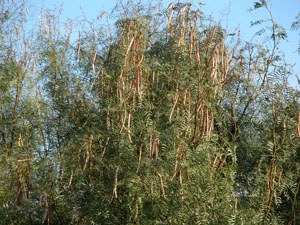
A honey mesquite tree loaded with pods. A common sight on the South Texas Plains, the tree was used in many ways by native peoples and is prized for it wood today. Photo by Phil Dering. |
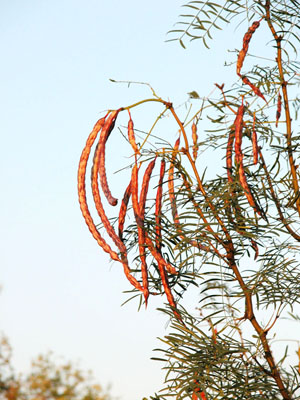
Pods hanging in clusters from a thorny branch. |
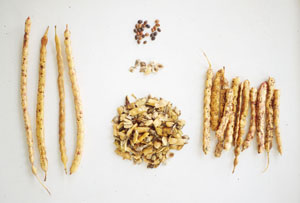
Whole pods, far left and right, seeds, center top, endocarps, center middle, broken pods bottom middle. |
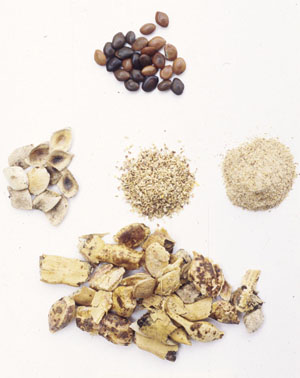
Mesquite seeds, endocarps, meal, and pods processed with experimental mortar and pestle. |
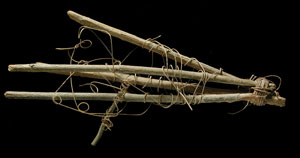
Snare of mesquite sticks, 41VV82 Coontail Spin (AMIS 27743) by Monica Trejo and Matt Peeples. |
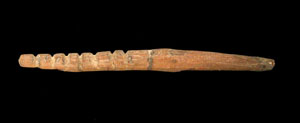
Rasping stick from 41VV162 Conejo Shelter, in the adjacent Lower Pecos region. (AMIS 23549). Photo by Monica Trejo and Matt Peeples. |